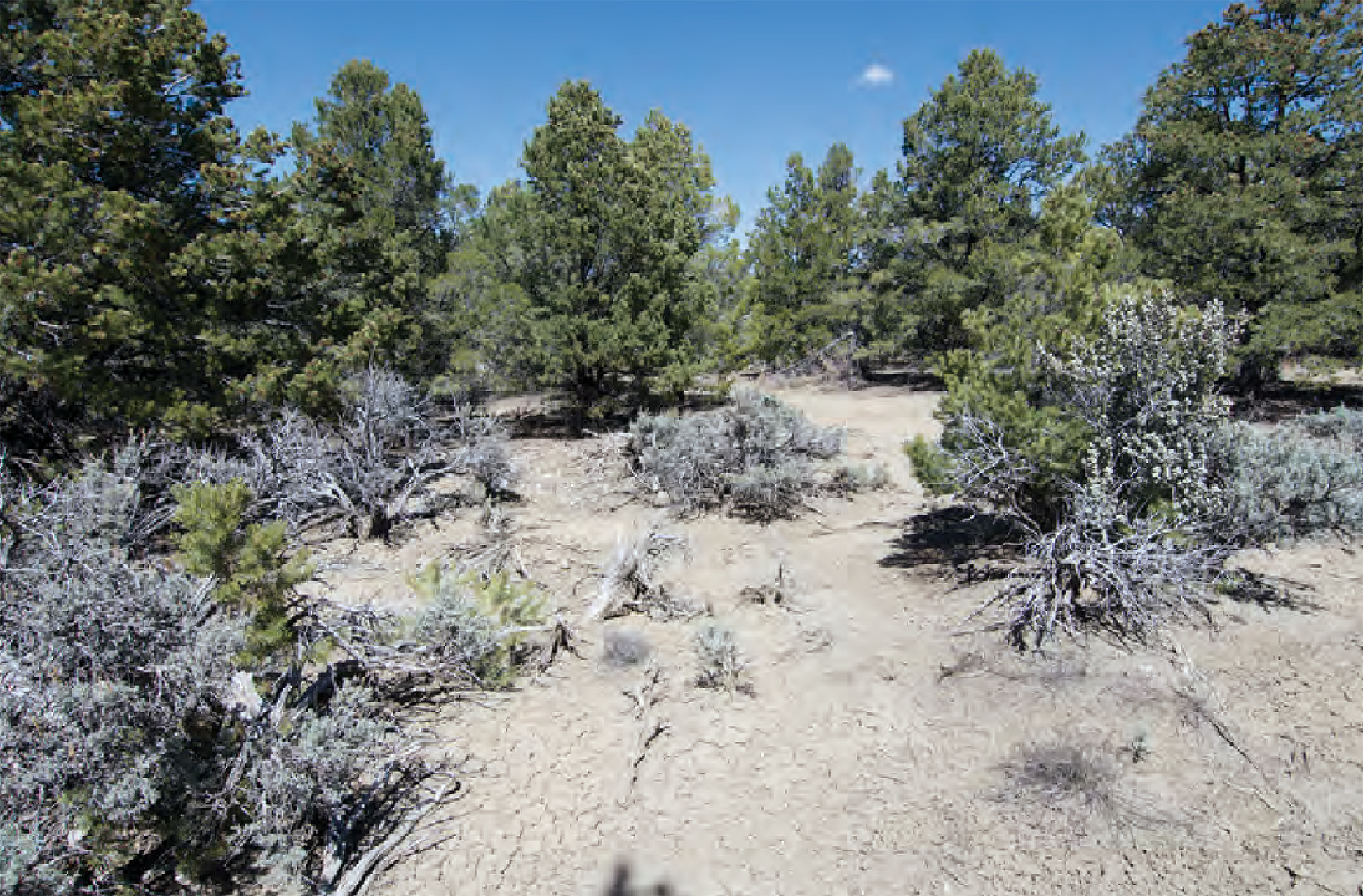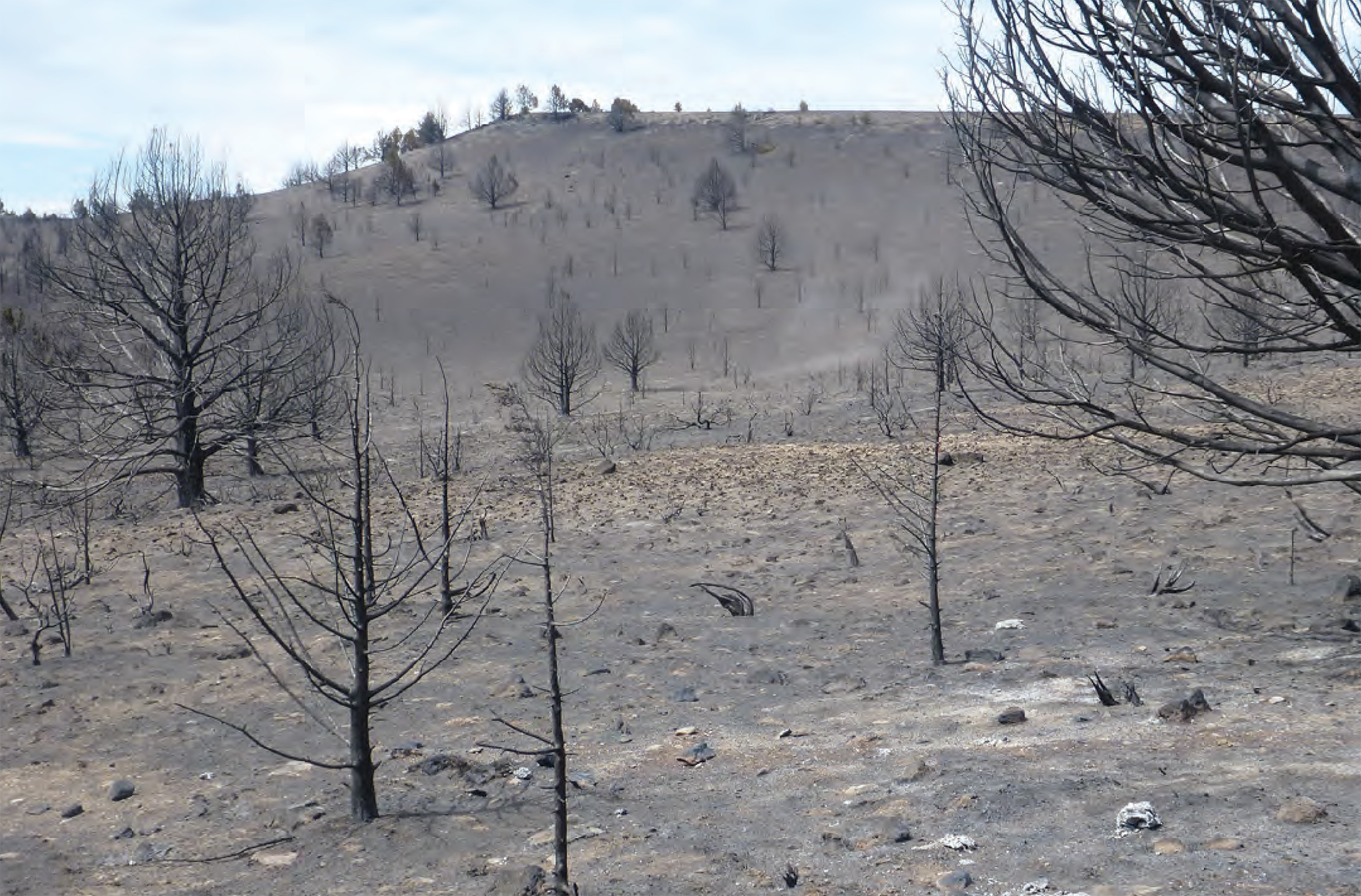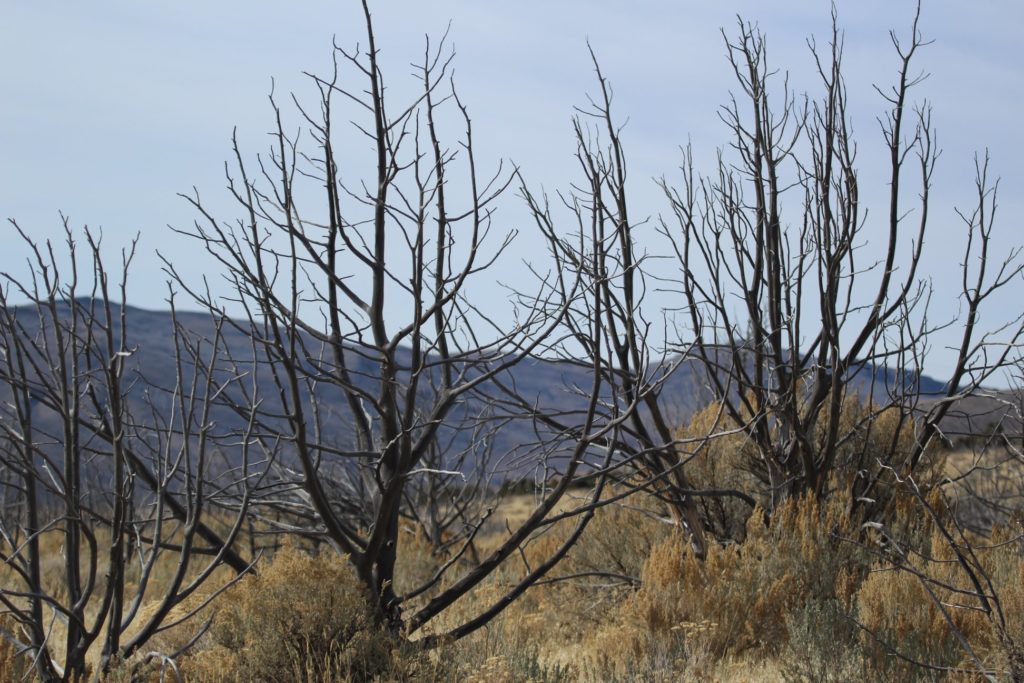Pinyon-Juniper Encroachment: Effects on Carbon and Nutrient Cycling

Key Points
- Encroachment leads to an increase in tree roots that travel farther and deeper than understory plant roots and uptake nutrients in the empty spaces between canopies.
- A decline in nutrients available for other plants in the interspaces between trees diminishes understory plant communities, increasing risk of non-native grass invasion.
- Aboveground carbon stocks increase with pinyon-juniper encroachment and are more susceptible to loss through fire, which can lead to greater cover of invasive species.
- Treatment of invading woodland, both through cutting and prescribed fire, can increase cover of perennial herbaceous plants and associated carbon storage and soil stability.
What is pinyon-juniper encroachment?
Pinyon-juniper encroachment is the expansion of pinyon-juniper woodlands into ecosystems that historically were shrublands or grasslands. These tree species have increased in abundance due to fire suppression, land use and favorable climate. A significant portion of this encroachment occurs in sagebrush rangelands and affects many processes within these ecosystems.’

Increased tree cover changes the availability of nutrients
Pinyon-juniper encroachment into sagebrush ecosystems significantly alters nutrient cycling and availability through changes in the composition and distribution of nutrient pools. As tree cover increases, the overall root system changes, with more far-reaching lateral roots close to the surface and tap roots that extend deep into the ground. This change in root structure results in the redistribution of soil nutrients, moving nutrients far away from shrubs or grasses rooted in the interspaces between tree canopies located in areas beneath the overstory trees. This limits successful establishment and growth of shrubs and perennial herbaceous plants. Additionally, trees obtain more nutrients than shrubs and grasses and ultimately store more nutrients in their leaves and litter. As litter accumulates at the base of trees, the result is islands of nutrient-rich soil adjacent to nutrient-deficient interspaces between trees. The accumulation of litter and nutrients beneath tree canopies can result in three to five times more organic carbon and nitrogen than in interspaces, which only increases as trees mature. Greater nutrient uptake from increasing tree cover leads to more bare area and smaller, more widely spaced shrubs and perennial grasses.

Encroachment effect on the carbon cycle
In sagebrush rangelands, over 90% of carbon is belowground in roots of perennial herbaceous plants, such as grasses and forbs. Invading pinyon-juniper woodlands dramatically alter the carbon cycle in sagebrush ecosystems by not only increasing aboveground carbon stocks, but by also reducing the belowground carbon pools associated with intact sagebrush ecosystems. While a large carbon sink may be beneficial for sequestering greenhouse gases, in areas susceptible to fire or drought, aboveground carbon pools are not a long-term carbon storage pool. High-severity fires can not only cause great losses in both aboveground and belowground pools, but also have the potential to increase invasion of non-native annual grasses (e.g., cheatgrass). Healthy rangeland communities can act as more permanent carbon storage since most of the perennial herbaceous plant roots survive fire and continue storing carbon. However, encroachment can lead to lower survival of carbon-sequestering understory plants, as increases in litter and downed wood fuel hotter fires that damage roots.
In addition to competition and potential for severe wildfire, pinyon-juniper encroachment also impacts surface (i.e., litter and shallow soils) and belowground carbon pools. Woodland expansion influences vertical distribution of carbon by increasing the overall amount and depth of root organic carbon, while also redistributing soil organic carbon to the top 15-20 centimeters through the decomposition of litter. Loss of perennial herbaceous plants leads to greater erosion, as fewer roots anchor the soil. Nutrients in the top layers of soil can be washed away as soil becomes eroded. With soil organic carbon allocated to less physically stable surface soils, management that encourages soil stability through promoting healthy understory communities can further improve carbon sequestration.

How does management influence carbon and nutrient cycling?
Management of encroaching pinyon-juniper can help restore a functional nutrient cycle and promote carbon storage through the return of healthy sagebrush ecosystems with perennial herbaceous plants. Reduction of pinyon-juniper tree cover through mechanical treatment (e.g., mastication, cutting) results in a change of nutrient uptake as the redistribution of nutrients is halted. Nutrients may even increase in some areas. The roots of trees decompose after cutting and slowly release nutrients, although deep soil carbon pools are not influenced by management. Leaving trees cut on site can result in greater litter and litter decomposition, which can cause more organic material in the soil and increase nutrient availability. However, there can be a decrease in surface carbon pools following tree removal on sites with limited understory cover, as lack of tree canopy interception combines with extensive bare areas to increase erosion. Perennial herbaceous plants can return quickly after management and can provide both a consistent soil organic matter pool and reliable carbon storage.
Treatment of woodland expansion through prescribed fire can also be favorable to nutrient availability. After fire, there can be a rapid increase in plant-available nutrients by processes that influence nutrient mobilization (e.g., volatilization, mineralization, increased decomposition rates). However, fires that are too severe can deplete nutrients from the soil. Combined cutting and burning can result in greater amounts of nitrogen, phosphorus and potassium within the first two years after treatment. While prescribed fire does have the potential to cause some loss of aboveground carbon and nitrogen, it is a tool that can be used to reduce woody fuels associated with pinyon-juniper encroachment with lesser effects on ecosystem carbon and nitrogen pools than high-severity wildfire. Under certain conditions, prescribed fire can encourage increased invasion of non-native annual grasses that further alter nutrient cycling, so the risk needs to be considered in the context of site characteristics and management history.
References
»Bates, J., Svejcar, T., Miller, R. F., & Miller, R. F. (2007). Litter decomposition in cut and uncut western juniper woodlands. Journal of Arid Environments, 70(2), 222–236.
»Bates, J. D., & Davies, K. W. (2017). Effects of conifer treatments on soil nutrient availability and plant composition in sagebrush steppe. Forest Ecology and Management, 400, 631–644.
»Canadell, J. G., & Raupach, M. R. (2008). Managing forests for climate change mitigation. Science, 320(5882), 1456–1457.
»Harrington, J., & Williams, M. (2008). Belowground carbon distribution in a pinon-juniper / short grass prairie site. In: Gottfried, Gerald J.; Shaw, John D.; Ford, Paulette L., compilers. 2008. Ecology, management, and restoration of pinon-juniper and ponderosa pine ecosystems: combined proceedings of the 2005 St. George, Utah and 2006 Albuquerque, New Mexico workshops. Proceedings RMRS-P-51. Fort Collins, CO: U.S. Department of Agriculture, Forest Service, Rocky Mountain Research Station. p. 75-80.
»Klemmedson, J. O., & Tiedemann, A. R. (2000). Influence of western juniper development on distribution of soil and organic layer nutrients. Northwest Science, 74, 1–11.
»McKinley, D. C., & Blair, J. M. (2008). Woody plant encroachment by Juniperus virginiana in a mesic native grassland promotes rapid carbon and nitrogen accrual. Ecosystems, 11(3), 454–468.
»Miller, R.F., & Tausch, R.J. (2001). The role of fire in juniper and pinyon woodlands a descriptive analysis. K.E.M. Galley, T. Wilson (Eds.), Proceedings of the Invasive Species Workshop: The Role of Fire in The Control and Spread of Invasive Species, Tall Timbers Research Station Miscellaneous Publication Number 11, Tallahassee, FL, p. 15-30.
»Miller, R. F., Chambers, J. C., Evers, L., Williams, C. J., Snyder, K. A., Roundy, B.A., & Pierson, F. B. (2019). The ecology, history, ecohydrology, and management of pinyon and juniper woodlands in the Great Basin and Northern Colorado Plateau of the western United States. Gen. Tech. Rep. RMRS-GTR-403. Fort Collins, CO: U.S. Department of Agriculture, Forest Service, Rocky Mountain Research Station. 284 p.
»Neary, D. G., Ryan, K. C., & DeBano, L. F. (2005). Wildland fire in ecosystems: effects of fire on soils and water. Gen. Tech. Rep. RMRS-GTR-42-Vol.4. Ogden, UT: U.S. Department of Agriculture, Forest Service, Rocky Mountain Research Station. 250 p., 042.
»Neff, J. C., Barger, N. N., Baisden, W. T., Fernandez, D. P., & Asner, G. P. (2009). Soil carbon storage responses to expanding pinyon– juniper populations in southern Utah. Ecological Applications, 19(6), 1405–1416.
»Rau, B. M., Tausch, R., Reiner, A., Johnson, D. W., Chambers, J. C., Blank, R. R., & Lucchesi, A. (2010). Influence of prescribed fire on ecosystem biomass, carbon, and nitrogen in a pinyon juniper woodland. Rangeland Ecology & Management, 63(2), 197–202.
»Rau, B. M., Johnson, D. W., Blank, R. R., Tausch, R. J., Roundy, B. A., Miller, R. F., Caldwell, T. G., & Lucchesi, A. (2011). Woodland expansion’s influence on belowground carbon and nitrogen in the Great Basin U.S. Journal of Arid Environments, 75(9), 827–835.
»Rau, B. M., Johnson, D. W., Blank, R. R., Lucchesi, A., Caldwell, T. G., & Schupp, E. W. (2011). Transition from sagebrush steppe to annual grass (Bromus tectorum): influence on belowground carbon and nitrogen. Rangeland Ecology and Management, 64(2), 139–147.
»Rau, B.M., Tausch, R.J., Reiner, A., Johnson, D.W., Chambers, J.C., & Blank, R.R. (2012). Developing a model framework for predicting effects of woody expansion and fire in ecosystem carbon and nitrogen in a pinyon-juniper woodland. Journal of Arid Environments, 76, 97-104.
»Roberts, C., & Allen Jones, J. (2000). Soil patchiness in juniper-sagebrush-grass communities of central Oregon. Plant and Soil, 223(1), 47–61.
»Strand, E. K., Vierling, L. A., Smith, A. M. S., & Bunting, S. C. (2008). Net changes in aboveground woody carbon stock in western juniper woodlands, 1946–1998. Journal of Geophysical Research: Biogeosciences, 113(G1). »Stubbs, M. M., & Pyke, D. A. (2005). Available nitrogen: A time-based study of manipulated resource islands. Plant and Soil, 270(1), 123–133.
»Throop, H. L., & Lajtha, K. (2018). Spatial and temporal changes in ecosystem carbon pools following juniper encroachment and removal. Biogeochemistry, 140(3), 373–388.
»Tiedemann, A. R., & Klemmedson, J. O. (2000). Biomass and distribution and system nutrient budget for western juniper in central Oregon. Northwest Science, 74,12.
»Wozniak S., Strand, E.K., Hulet, A., Johnson, T., Roundy, B., & Young, K,. (2020). Treatment Longevity and Changes in Surface Fuel Loads after Pinyon-Juniper Mastication. Ecosphere, 11(8), e03226